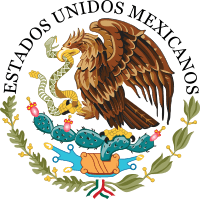Manuel González Flores
| Manuel González | |
|---|---|
 | |
36th President of Mexico | |
|
In office 1 December 1880 – 30 November 1884 | |
| Preceded by | Porfirio Díaz |
| Succeeded by | Porfirio Díaz |
| Personal details | |
| Born |
18 June 1833 El Moquete, Matamoros, Tamaulipas[1] |
| Died |
10 April 1893 (aged 59) Chapingo, State of Mexico[2] |
| Nationality | Mexican |
| Political party | Liberal |
Manuel del Refugio González Flores (18 June 1833 – 10 April 1893) was a Mexican military general and liberal politician who served as the 36th President of Mexico from 1880 to 1884.[3] Before initiating his presidential career, González played important roles in the Mexican-American war as a lieutenant, and later in the Reform War as general, in the service of the Conservative Party. González was also governor of Michoacán (1877) and Guanajuato (1885) and served as Secretary of War and Navy from 1878 to 1879.
Manuel González is the first president of Mexico from Tamaulipas that has been elected through popular vote; Emilio Portes Gil, also from Tamaulipas, became the interim president of Mexico after the assassination of Álvaro Obregón in 1928.
Early life and military career
González was born in Matamoros, Tamaulipas, Mexico. He began his military career in 1847, fighting the invaders from the United States after they killed his father, a farmer. From 1853 to 1855, he fought with the Conservative forces supporting General Antonio López de Santa Anna. At the time of the Plan de Ayutla in 1854, he was with Conservative General Leonardo Márquez in Oaxaca, fighting against Liberal Porfirio Díaz.
In 1856, he was wounded at the Battle of Ocotlán (1856), fighting with rebels against President Ignacio Comonfort. In March 1859, he took part in an attack on Veracruz by Conservative General Miguel Miramón, against the legal, Liberal government of President Benito Juárez. In 1860, he took advantage of an amnesty for the Conservatives decreed by Congress and offered his services to the Liberals fighting against Maximilian of Habsburg and the French invasion.
González served under Porfirio Díaz. He participated in the defense of Puebla against the French in 1862. He was wounded and taken prisoner, but escaped. In 1863, Díaz made him chief of the Army of the Center. He fought under Díaz in the battles of Miahuatlán and La Carbonera, Oaxaca.
González was taken prisoner by the French a second time in 1865, but he was paroled and rejoined the Mexican army. In 1867, he participated in the sieges of Puebla (where he lost his right arm) and of Mexico City. On 7 September 1867, after Juárez's forces had retaken the capital, the president named him military commander of the Federal District and governor of the National Palace.
From 1871 to 1873, he was a federal congressional deputy from Oaxaca. He supported Díaz in revolt under the Plan de la Noria (Díaz's 1871 unsuccessful revolt against Juárez) and the Plan of Tuxtepec (his successful 1876 revolt against then-President Sebastián Lerdo de Tejada). Vicente Riva Palacio, liberal politician, intellectual, and military man, served in his government.[4]
On 13 March 1877, he obtained the rank of general of division. Díaz named him governor and military commander of Michoacán (1877–79) and secretary of war and the navy (28 April 1878 to 15 November 1879).
Political career
As president of the Republic

After elections in 1880, Congress declared him president. He served from 1 December 1880 to 30 November 1884, both proceeded and succeeded by Porfirio Díaz. Díaz was a minister in his government. During his administration, the railway from Mexico City to El Paso, Texas, was inaugurated and the Banco Nacional de México was founded. Relations with Great Britain were renewed, and Mexico recognized the British debt claims under onerous conditions. This latter concession provoked disturbances in the capital.
He issued nickel coins, which provoked rioting on 21 December 1883. With his characteristic valor, he appeared before the rioters, actually receiving cheers before he finished speaking.
He established agricultural and industrial colonies of 1,500 Italians in the state of Puebla. He declared primary education to be free and obligatory. He inaugurated Mexico's first submarine cable. On 20 December 1882, the metric system of measurements was established in Mexico. A dispute with Guatemala over Chiapas and Soconusco was resolved peacefully.
During his term, the Constitution of 1857 was amended to remove the right of succession to the presidency from the office of president of the Supreme Court. Instead, the president of the Senate was named next in succession, or the president of the Permanent Commission, in the event that the Senate was in recess.
After the presidency
After his presidency, he was charged of misappropriation of public funds by the Congress and the case was referred to a Grand Jury, but the charges were never pressed.[2] Instead, González was elected governor of Guanajuato "unanimously" in 1884 and served in office until his death in 1893, after a failed attempt to succeed General Díaz in 1887.[2]
See also
References
- ↑ "Manuel González" (in Spanish). Instituto Nacional de Estudios Históricos de las Revoluciones de México – Unidad Bicentenario. Retrieved 4 September 2009.
- 1 2 3 "Manuel Gonzales Dead". New York Times. 11 April 1893. Retrieved 4 September 2009.
- ↑ "36° presidente de México: Manuel González". Presidentes.mx. Retrieved 8 August 2011.
- ↑ http://www.lib.utexas.edu/taro/utlac/00031/lac-00031.html
Further reading
- "González, Manuel", Enciclopedia de México, vol. 6. Mexico City, 1996, ISBN 1-56409-016-7.
- García Puron, Manuel, México y sus gobernantes, v. 2. Mexico City: Joaquín Porrúa, 1984.
- Orozco Linares, Fernando, Gobernantes de México. Mexico City: Panorama Editorial, 1985, ISBN 968-38-0260-5.
| Political offices | ||
|---|---|---|
| Preceded by Porfirio Díaz |
President of Mexico 1 December 1880 – 30 November 1884 |
Succeeded by Porfirio Díaz |
